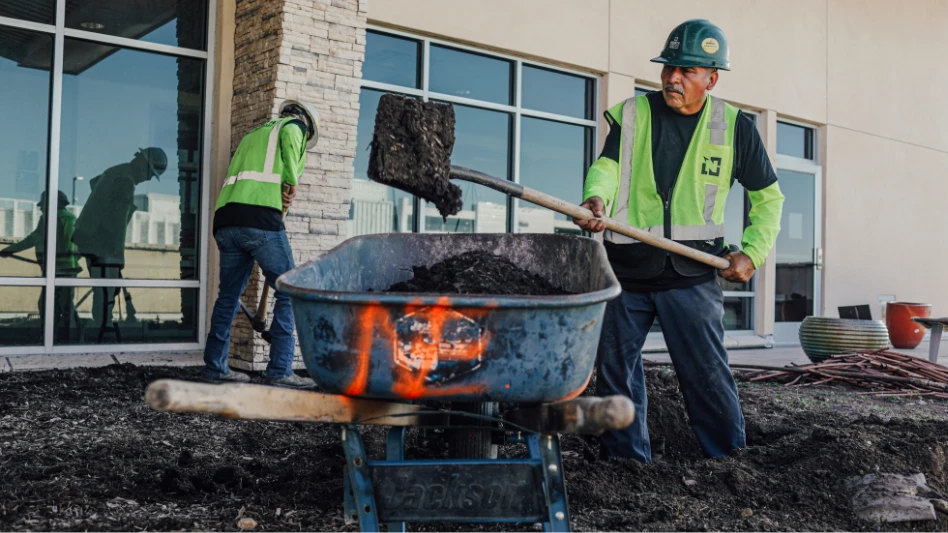 This year has seen its fair share of weird weather. Most of the Midwest, East Coast and transition zone have seen record rainfall and unusually mild temperatures, while drought continued to plague the West.
This year has seen its fair share of weird weather. Most of the Midwest, East Coast and transition zone have seen record rainfall and unusually mild temperatures, while drought continued to plague the West.
In the Midwest and East Coast particularly, the cooler, wetter weather sets the stage for vulnerable grass. “Turf doesn’t perform well when it’s shaded a lot,” says Kyle Miller, senior technical specialist at BASF. “And a rainy day, I’m going to equate to turf being in the shade. Because of that, the turf is weaker; it’s thinner and more spindly, and more susceptible to stresses on it.”
The types of diseases that will need treating depend on the type of grass on the lawn as well. Cool season grasses such as Kentucky bluegrass, creeping bentgrass, tall fescue and perennial ryegrass are infected with diseases like dollar spot, red thread and gray leaf spot. Warm season grasses like zoysia, St. Augustine and bermuda typically see diseases such as zoysia patch, brown patch, dollar spot and leaf spot.
Recognizing the problem. It’s important to know what you’re treating. “Diseases can look very similar to one another and you want to make sure you’re treating with the right product that’s going to provide protection or be a curative,” says Jill Calabro, plant pathologist and regional field development manager at Valent. “Have a disease diagnosis done if there’s any question of what the disease is, relying on a university diagnostic lab.”
Visual indicators can help with narrowing down which diseases may be present. Brown patch is active through summer and into mid-September, and shows lesions on the leaf blade with irregular margins, says Derek Settle, green solutions specialist at Bayer. The margins are a chocolate brown/red color, and the interior of the lesion is a tan color. The colors are important because brown patch can easily be mistaken for dollar spot, which has a bleach white center lesion more regular margins.
 “Scouting is key,” says Matt Giese, technical field manager at Syngenta. “Especially if we do have some of these weather conditions that kind of creep into fall, it’s important to continue to watch leaf blades.” Things like dollar spot and brown patch can linger into the fall, he says.
“Scouting is key,” says Matt Giese, technical field manager at Syngenta. “Especially if we do have some of these weather conditions that kind of creep into fall, it’s important to continue to watch leaf blades.” Things like dollar spot and brown patch can linger into the fall, he says.
With gray leaf spot, there will be patches in the grass, but they usually aren’t as large as brown patch, says Steve Jedrzejek, marketing manager of Nufarm Americas. There will be spots on the leaves themselves that are tan or gray in color. “With either of these diseases, brown patch or gray leaf spot, you can get some fuzzy mycelium growth or spore mass growths when you have wet conditions,” he says.
With red thread, you have foliar symptoms. “It gets its name from the various thin strands, that reddish colored mycelium that you particularly see when you have some moisture out there,” Jedrzejek says.
Reactive treatment. With the unusually wet conditions in much of the country, more diseases on cool season grasses, such as brown patch and some pythium are likely, says Nathan Walker, professor of Turfgrass IPM/Turfgrass Pathology at Oklahoma State University. “What that means is going into the fall, landscape managers may need to reseed some of those areas that had diseases this summer,” he says.
Since the grass will be going dormant in the winter in cooler climates, the solution to the major damage from summer will be in the form of reseeding, overseeding and fertilizing to get the grass back in shape, Settle says.
|
What not to do “They want those grasses to go dormant,” Walker says. “Normally, if they fertilize them late, it’s going to keep them active and they won’t go dormant. That just prolongs the window that diseases can be active in the fall, which will make them more severe in the spring.” Getting overzealous with your water and fertilizer in the fall is actually detrimental to plant health efforts. You have to find a balance in order to keep the turf healthy through winter and into next spring. “It’s sort of like our human diet,” Giese says. “Overdoing something can eventually cause a problem. Having moderate fertility, having moderate or adequate water needs … will really help you in trying to manage the diseases. If you get on the extremes of either of those, that’s when you start to see some of those opportunistic diseases come in.” |
If you have extended wet conditions conducive to disease prevalence in the fall, something in the DMI chemistry of fungicides would be an option for dollar spot and brown patch as a curative-type application, Giese says.
Something else to consider when doing reparative work is a disease called damping off, which is where either pythium or Rhizoctonia kills the turf seedlings themselves. “During the renovation process and shortly after seeding, either the seed will not come up or it will germinate and the seedlings will quickly die,” says Jim Kerns, turfgrass pathologist at North Carolina State University. “There is really no good indicator of which fungus you are dealing with, so typically we just recommend a tank mixture of mefenoxam, azoxystrobin, pyraclostrobin, and/or trifloxystrobin.”
Preventative treatment. Experts agree that the best offense is a good defense: turf diseases are best managed and prevented with good soil practices. “Anything you can do to promote good health, anything you can do to reduce the stress of the plant, will help defend itself against disease encroachment,” Jedrzejek says. “Practices such as having good balanced fertility, that goes a long way to fortifying the plant to be able to defend itself against biotic infections or diseases infections.”
If an area of a lawn has been infected with a disease in the past, it’s safe to assume that it may be affected again. Using a broad-spectrum fungicide as a preventative measure may help reduce the risk of a repeat appearance.
“It’s important to stress being proactive in terms of treating before you start seeing symptoms,” Calabro says. “Curative applications are much more difficult because the turf takes so much time to recover.”
Preventative practices include fungicide applications, aerification and maintaining proper levels of fertilizer and irrigation. Long-term preventive measures could also be taken, such as ensuring appropriate drainage and planting disease-resistant turf species.
“Aerification practices for cool season lawns in the fall are usually extremely important,” Settle says. “For warm season lawns, you also do aerification, but aerification for warm season grasses would be in the summer when they are growing.” Several families of fungicides can be used in the fall to prevent diseases from occurring the following spring. Two major fungicides are the strobilurins, which attack rhizoctonias, and the DMIs, which are good for large patch that is attacking the cool season grasses.
“You have to think about Integrated Pest Management, and a lot of these fungicides that are really good for rhizoctonia give you broad spectrum control for other diseases,” Settle says.
Specific to large patch on zoysiagrass, a fall application is particularly helpful, Giese says.
“If you have a zoysiagrass grass property that a contractor may be maintaining and you know that there is a history (of large patch) there, it’s important to make fall applications of fungicides to try to prevent that going into the spring,” he says.
For management of zoysiagrass, as soon as soil temperatures start to hit 70 degrees, applications of either azoxystrobin, pyraclostrobin or flutolanil could be used to manage large patch, which typically shows up in late fall or early spring, Kerns says. “We have seen the best results with two fall applications, and if you miss those fall applications, we don’t see very good results with spring applications.” Likewise, dollar spot on bermudagrass and leaf spot on St. Augustine grass should be pretreated with fall applications, Miller says.
“It’s actually a spring problem, but you need to be treating in late fall in order to control the problem the following spring.” Miller also recommends DMIs and strobilurin fungicide applications.
|
Whatever it takes Slow-release fertilizer helps one LCO focus on other areas of client care. New Leaf Landscape Maintenance in Bridgehampton, N.Y., services 160 high-end second homes in the Hamptons. For a five-figure annual contract, clients get a one-stop shop for all their landscape needs, including turf care. The contract doesn’t specify a six-, eight- or 12-step program. It just says crews will do “whatever the house needs,” says Kevin J. Kenny, senior account manager. “All they want is healthy turf and a healthy landscape. They want to come down here on the weekend and not worry about talking to us.” But combine high expectations from clients with New York’s phosphorous prohibitions, and that can be difficult. So New Leaf relies on Agrium’s slow-release Duration fertilizer to maintain high-quality turf. The company has just one lawn care technician, and the slow release products allow him to apply the correct amount of fertilizer early in the season and not scramble to hit 160 homes in a few days when the weather finally cooperates. Instead, that employee does other jobs and stays on the look-out for other problems, which can be handled proactively for clients. “They just want (the lawn) to be healthy all the time,”he says. “If you set their expectations correctly, they know lawns get disease and insects form time to time. As long as you can find it and correct it, you can control it right away.” – Chuck Bowen |

Explore the September 2013 Issue
Check out more from this issue and find your next story to read.
Latest from Lawn & Landscape
- Ever-changing landscape of SEO
- Fleetio acquires Auto Integrate, raises $450M in Series D funding
- Davey Tree expands in St. Paul, promotes Ostlie to district manager
- Schill Grounds Management taps 3 for senior leadership roles
- HD Hyundai Construction Equipment North America adds to wheeled excavator lineup
- High maintenance
- From Design to Proposal: Estimating and Rendering Support Services
- PERC adds Joel Stutheit as senior manager of business development





